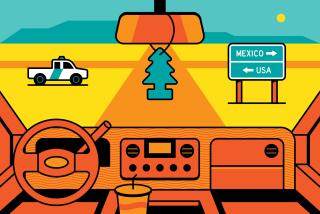A Baja Trip: Getting There Is Half the Fun
- Share via
Our first trip to our Baja house in almost two years was the usual series of adventures and misadventures, with some harrowing moments and a near disaster.
When we crossed the border, the Mexican guards, as usual, passed us through with a wink. We were soon on the Baja coast, heading south toward Ensenada, past burgeoning seaside communities.
The population certainly had doubled since we first found our home site 20 years ago. Condominiums like beehives had sprung up in the resorts along the shore. Most looked like white Castilian castles, with domes and turrets and arched windows.
My fears that if the United States took over the peninsula it would be turned into Miami Beach seemed idle; the Mexicans were doing it themselves. Most of the condominiums seemed unoccupied; I wondered if, like so many ambitious Baja projects, they would become graveyards in the sand.
Rosarito was teeming. The main street was full of locals. Dusty old American cars were parked along the edges. Gaudy storefronts jostled one another for attention. Music blared out of bars. Stubby new hotels rose above the clutter.
We lunched as always at the Rosarito Beach Hotel. It was built as a gambling casino, and now retains a decadent grandeur. The gambling halls have been converted to other uses. The restaurant looks out over the swimming pool and beyond to the Pacific. The ocean was blue and shiny.
In Ensenada we stopped only at the liquor store to buy two six-packs of Corona, then drove on south through Maneadero, the farm center 10 miles south of town. For an American driving through its main street, Maneadero is a tension-making hazard. Dogs and donkeys cross the road. Women and children cross the road. Schoolgirls with their books cross the road. Old trucks and tractors pull out into the road from the side. It is like taking one of those driving tests where a machine creates dangerous situations that you must avoid. I was not reassured by the sudden realization that I had neglected to take out Mexican insurance.
We drove on south through the mountains to the Santo Tomas River Valley, where our dirt road begins. By then it was 4:30 in the afternoon, and my wife pointed out that the sun set about 5:30. We always hate to arrive in the dark. There are too many uncertainties.
We were driving the Chevy van we had obtained in a dubious trade with our younger son. He wanted our Toyota pickup for his son. The van is 14 years old, but it performed valiantly on the dirt road that has been cut into the low mountains along the valley. Hoping to beat the sun, I drove too fast over the washboard road, and the van protested with an ear-shattering cacophony of creaks and rattles.
We could see the sky turning red over the low peaks ahead of us. When we came to Gomez’s store at the mouth of the river, the sun was gone. We did not stop. I wanted to get to the house while there was still some afterlight. I knew that Gomez was building a new house near ours, and that he was building it in the center of the old road, as he had ours. I knew there was a new road, and I didn’t know whether I could find it in the dark.
We took the old road and our headlights soon turned up the new house. Its brick walls were only half up. It was a dead end. I had to back out. By then the last light had faded. I came to a fork and took it. I probed through the dark, looking for the house. For a second, I saw it in my lights, but I couldn’t find the road down to it. My wife said she would get out and try to find the way. I drove on half a mile, looking for a place wide enough to turn around. Finally, I came to a side road that went down toward the cliffs. I took it and came to a fork that seemed to go back toward our house. In a minute, my headlights picked up my wife, waving her arms wildly. I drove in her direction and finally found myself in back of the house.
We were there.
More to Read
Sign up for The Wild
We’ll help you find the best places to hike, bike and run, as well as the perfect silent spots for meditation and yoga.
You may occasionally receive promotional content from the Los Angeles Times.






